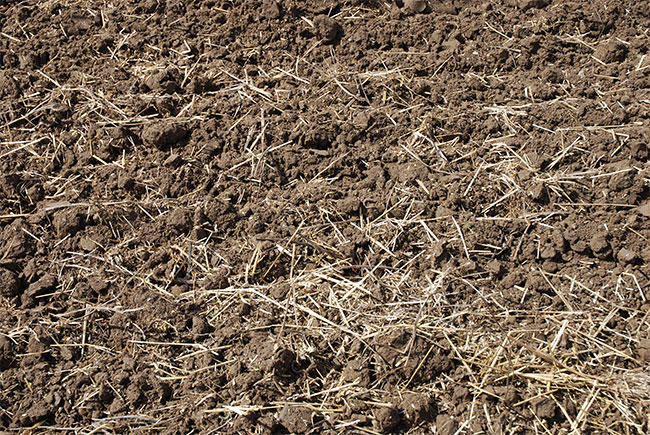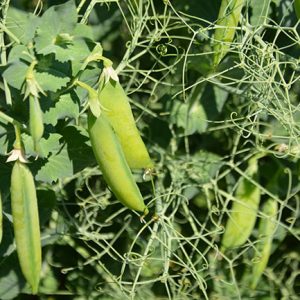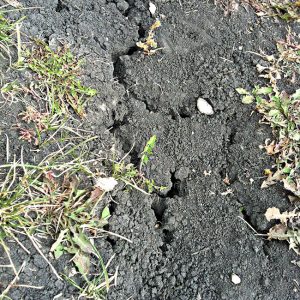
Features
Soil
Unearthing complexities
Exploring the effects of mycorrhizal inoculants.
August 16, 2021 By Carolyn King
 Tillage can disrupt AMF hyphae in the soil, which can reduce AMF populations when combined with non-host crops. Photo by Top Crop Manager.
Tillage can disrupt AMF hyphae in the soil, which can reduce AMF populations when combined with non-host crops. Photo by Top Crop Manager. Soil fungi called arbuscular mycorrhizal fungi (AMF) are known to provide vital benefits to plants. So the use of commercial AMF inoculants in crop production is increasing. But we still have much to learn about the impacts of these inoculants on a soil’s resident AMF community and about when the inoculants are likely to be beneficial. Scientists Fran Walley and Miranda Hart are both investigating these issues, but from different perspectives.
“Arbuscular mycorrhizal fungi occur naturally almost everywhere – certainly in agricultural soils. AMF have a very close relationship with plants, living inside the roots of most plants on the planet. In fact, the evidence suggests that plants and these fungi evolved together from the beginning, as plants left aquatic environments and moved onto the land,” notes Walley, a professor of soil science at the University of Saskatchewan.
Mycorrhizae are propagated by spores or fungal threads called hyphae. These propagules infect plant roots, but instead of causing disease, the fungi work with the plant for mutual benefits.
“The fungi get their food and nutrition from the plant. In return, the fungi help the plant by doing different functions,” says Hart, a professor of biology at the University of British Columbia’s Okanagan campus. “For example, they are better at acquiring certain nutrients than plant roots, and they can also protect against pathogens.”
Walley explains that AMF hyphae extend out beyond the root into the soil. “The super-thin hyphae can get into little nooks and crannies in the soil and soil micropores that roots can’t access. They really expand the volume of soil that the plant can explore.” AMF are particularly useful for capturing relatively immobile nutrients like phosphorus.
Digging into inoculant impacts
“The plant-AMF relationship is amazingly important for crop production. If you go to any field with crops like wheat or peas, virtually every one of those roots will have these fungi. And yet we mostly ignore this relationship. We know very little about how agricultural practices affect it,” Walley notes.
“I think we should be interested in anything that can disrupt this extraordinary and extraordinarily beneficial relationship.”
Walley and her research group have been conducting AMF studies over the years, including recent research on commercial AMF inoculants for field crops.
“For years there was this idea: what if we could produce a commercial AMF inoculant for field crops? But people were unable to grow AMF in a typical lab situation, such as culturing them in a flask, because these fungi are so reliant on their host plant. However, researchers worked out how to culture one particular AMF species in a way that produces the vast amount of spores needed to develop commercial inoculants for field crops. So the currently available inoculants all contain that same species,” she notes.
“However, a whole host of different types of AMF are in our soils. So I wondered: What happens if we add a single-source inoculant into the soil? What impact might it have to release a non-indigenous strain into our soils, which already contain a very healthy and vibrant population of various AMF? Is it possible that the inoculant might have a negative effect on the AMF community structure that already exists and has been there as the soil developed?”
Growth chamber experiments by her research group show that some AMF species are better than others at enhancing plant growth. “So, if we are going to add a single AMF species to the soil, that AMF species better be good at enhancing nutrient uptake, for instance, and hopefully better than what is already in the soil.”
In a recent field experiment, Walley’s group explored an important aspect of this issue. “We were asking the question: if we use this commercial inoculant, will it have an impact on the native community of AMF species? Is this single AMF species going to start to take over this system?”
This three-year experiment took place in Swift Current (Brown soils), Scott (Dark Brown), Outlook (Dark Brown) and Melfort (Black). The study team, with then-PhD student Nazrul Islam, took soil cores at each of the four sites and re-installed those cores at all the sites. Each core was encased in an open-ended aluminum cylinder. At each site, a commercial AMF inoculant was applied to half of the cores in year one; the rest of the cores were used as controls. Then a pea/wheat/pea rotation was grown in the cores. No AMF inoculant was applied in years two or three.
Soil, climate and the indigenous AMF community all influenced the inoculant’s persistence and its impacts on that community. The inoculant was detectable for three growing seasons at the Swift Current and Outlook sites, two seasons at Melfort, and one at Scott.
“The inoculant shifted the AMF community, but in a way that was not predictable. At some sites there was a fairly big shift in the community composition, whereas at other sites there was only a modest shift that didn’t necessarily persist,” Walley notes.
“Bottom line, the study showed that using an AMF inoculant can impact the AMF community composition. Whether that impact will be positive or negative [for the soil microbial community and for crop production] is yet to be determined. So the next step is to ask: Do we need to worry about that impact? And that is still an unanswered question.”
She adds, “I love the idea of having a commercial inoculant because AMF are so important. But we don’t fully understand yet whether the impacts will be consistently good, or neutral, or potentially bad, if native communities are negatively affected.”
Another angle on AMF inoculants
Hart is concerned that AMF inoculants could spread beyond crop fields and pose a threat to indigenous AMF communities and the native plants that depend on them.
“The reason I’m a biologist is because I love nature and wilderness and I want to preserve nature. I started wondering if these inoculants might be invasive species, as opposed to just management tools, because they are living organisms. And the more I got into it, I realized that there wasn’t any real legislation or rules about their use, and that seemed worrisome to me,” she says.
“One of the things that most worries me is that these inoculants are being marketed as being beneficial for soils. But the reality is there is not enough research to say that yet.”
Hart explains, “The evidence from my work shows that inoculation can be inconsistent. Sometimes the inoculant doesn’t even establish. Sometimes it establishes and you still don’t see an effect. And sometimes you’ll see an improvement in crop performance. For example, I did some [horticultural] studies where there was an improvement in crop establishment post-transplant. Some studies have shown small increases in yield. And then sometimes inoculation is detrimental, with decreases in biomass.”
According to Hart, not a lot of research has been done to evaluate the risk to natural areas from AMF inoculants. That is partly because tracking the persistence and spread of inoculant strains has been difficult because AMF species closely related to the inoculant strains occur naturally in soils all over the world. Fortunately, recent advances in molecular tools are enabling Hart’s group and others to track the inoculant strains.
Similar to Walley’s study, Hart’s research shows that an inoculant’s effect on an indigenous fungal community is not easily predictable. “In some cases, the inoculated fungus can replace the pre-existing community. In some cases, the fungus establishes but doesn’t really change the fungal biodiversity. And sometimes it fails to establish. But it’s not clear what conditions foster each outcome.”
Hart is working on various field and greenhouse AMF studies. “I’m trying to figure out how microbes spread, how fast they spread, how far they spread. So when you use an inoculant, are there conditions where the fungus is going to spread uncontrolled? Could we manipulate our cover crops to keep it within an area?”
She cautions, “I think you can mitigate some of the onsite spread of an inoculant, but I don’t know that it is going to be successful in the big picture. Microbes move in all sorts of ways – in the water table, on animals, in the atmosphere; they move between continents.”
Her field studies include vineyards, grain cropping systems and natural areas. She works with local farmers who are already applying AMF inoculants. “Here in the Okanagan Valley, grape vine growers are very keen to try different sustainable approaches, and many are using inoculants.”
Hart is also investigating how AMF inoculants affect the functioning of a natural soil ecosystem once the inoculated fungi establish there. “Let’s say these fungi get in and they change native soil communities. That sounds bad, but if the soil ecosystem is still functioning properly then maybe it’s not such a bad thing after all. Or conversely, maybe they are completely changing how that soil ecosystem works. We don’t know. So I’m trying to look at unintended consequences below ground.”
Considerations for growers
Since crop response to AMF inoculants can vary considerably depending on such factors as the existing soil microbial community, host crop, soil properties and weather, it will be hard to predict whether AMF inoculation will provide a crop benefit in your field.
If you are planning to use an AMF inoculant, Walley suggests a strip trial could be helpful. Perhaps the indigenous AMF community that has developed under your particular field conditions is actually well suited to those conditions and will outperform a non-native inoculant.
She doesn’t have a recipe for increasing AMF populations in your fields. “Although more and more AMF research has been done over the years, we still actually know very little about the impact of different agricultural practices on AMF communities. I’m not sure I can point to research – certainly not research that I’ve done – that says here are the end strategies you can take to increase AMF.”
However, she can point to several factors that will influence your AMF populations.
“Some crops are not hosts to AMFs. Anything in the Brassica family, such as canola or mustard, is a non-host crop, so it is not unusual to have a slight reduction in the number of viable AMF propagules after a Brassica crop. Although wheat is a host, it is not highly responsive to AMF, in part because it has a really vibrant and extensive root system. Crops like peas or flax are highly mycorrhizal because their roots tend to be coarser and not as extensive as some cereal crops,” she explains.
“Tillage can disrupt the AMF hyphae in the soil. If that is combined with growing a canola crop or having a non-crop year where there are no host plants, a fallow year for instance, it could also reduce the AMF population. I’m fairly sure that long-term flooding might have a similar effect.
“So the number of infective AMF propagules in the soil could decline over time due to any of those circumstances. And you could imagine a scenario where you’re planning to grow a highly mycorrhizal crop following a year where the AMF propagules might have declined. So perhaps those are conditions where using an AMF inoculant might be beneficial.”
But Walley points out, “Even if the propagules have declined, AMF are always present. In fact, it would be very hard to find a field where there were none.”
From Hart’s perspective, using AMF inoculants in a field situation is risky until we learn more about AMF biology and ecology. “Do you want to introduce foreign strains into an ecosystem, knowing that you can’t control what happens, knowing that you don’t know what’s going to happen to soil biodiversity?”
For now, Hart thinks an inoculant should be used only in specific situations where AMF are not already present. One example would be horticultural crops grown indoors in hydroponic systems. “Using AMF inoculants in that situation totally makes sense. Number one, the plants don’t have any mycorrhizal fungi to begin with, so if you give them some mycorrhizae, they will always do better. And number two, the fungi are confined, so they are not going to spread uncontrolled in the environment.”
Walley hopes to do more AMF studies in the near future so crop growers will have better information about how to nurture and enhance the AMF community in their fields. “We really need a better understanding of what impacts all our cropping practices and management systems are having on AMF. Part of having a healthy soil is promoting these really great organisms that plants rely on very heavily.”

